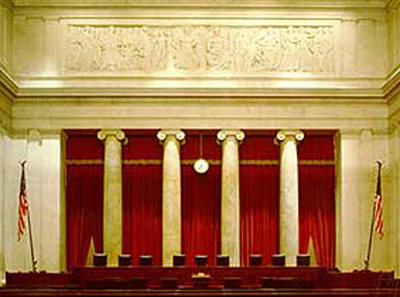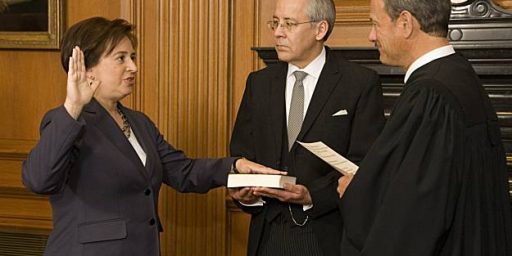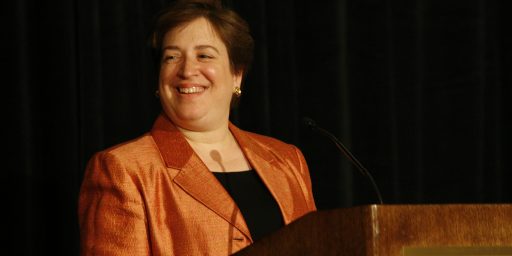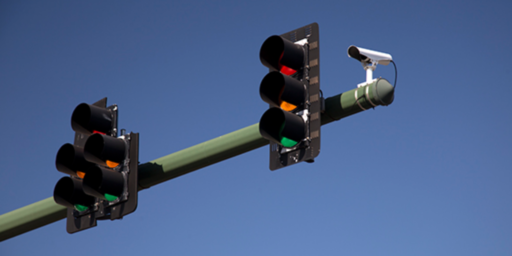Elena Kagan Supportive Of Cameras At The Supreme Court
 One of the many smaller issues that have come up in the days since President Obama named Elena Kagan to replace Justice John Paul Stevens is the revelation that Kagan is apparently open to the idea of allowing oral argument in the nation’s highest court to be televised:
One of the many smaller issues that have come up in the days since President Obama named Elena Kagan to replace Justice John Paul Stevens is the revelation that Kagan is apparently open to the idea of allowing oral argument in the nation’s highest court to be televised:
In addition to meeting with Brown and Collins on Thursday, Kagan stopped by the offices of five key Senate Democrats: Massachusetts’ John Kerry, New York’s Chuck Schumer, Maryland’s Ben Cardin, Minnesota’s Amy Klobuchar and Pennsylvania’s Arlen Specter.
Specter said Kagan may be open to the idea of allowing television coverage of Supreme Court hearings.
“She said it’d be helpful to the public and to the court,” he said. “This was the best answer I’ve gotten” from any recent Supreme Court candidate.
Specter is a staunch advocate of allowing television cameras into the high court. Most justices, however, have adamantly opposed the idea.
Kagan’s remarks to Specter mirror comments she made at a Judicial Conference last year:
If cameras were in the courtroom, the American public would see an amazing and extraordinary event. This court I think is so smart and so prepared and so engaged. And everybody who gets up there at the podium is — the toughest questions, the most challenging questions are thrown at that person.
The Court has been far more open to making it’s proceedings public in recent years than it has in the past. Audio recordings of oral argument are made available on a regular basis, rather than being archived for years. In some cases, such as the oral argument two years ago in District of Columbia v. Heller, the landmark Second Amendment case, those recordings were made available to the public immediately after oral argument had concluded. It wouldn’t be that much of a stretch, then, for the Court to agree to allow C-Span cameras into it’s historic courtroom.
There are, of course, plenty of arguments against televising Court proceedings, and Exhibit A on anyone’s list would be the O.J. Simpson trial. Appellate Courts, though, strike me as being so completely different from trial courts that concerns about attorneys or judges grandstanding for the camera are much more remote. In all honesty, most of the cases that the Supreme Court, or any of the Federal appellate-level Courts, hear on a regular basis aren’t ones that would garner that much interest from the general public. It’s the exceptions, though, the Bush v. Gore’s, or the Heller’s, that argue strongly in favor of lifting the last veil of secrecy and letting Americans see their system at work.






Video recording analogous to audio recording or stenography, done by a small court-appointed team? Sure.
But live coverage with multiple newsgroup cameramen and reporters? I don’t know, it changes people’s behaviors and can definitely lead to the OJ Simpson thing.
We’d be talking about C-Span coverage here, obviously.
With the camera under the control of the Chief Justice, or the Clerk.
My state’s Supreme Court already televises its arguments. What viewers see is generally incomprehensible.
I think one of the problems is that justices ask provocative questions that appear to suggest the way they will rule. Take Scalia’s question about what’s wrong with strip-searching a student. Right now that stuff circulates through the print media for consumption of about 0.5% of the population. What happens to those types of exchanges when filmed?
OJ Simpson? Since when does the SC handle lurid murder trials?
Ahh, okay, thanks. Sounds reasonable.
That is an interesting point, true. The unwashed masses will likely make much ado about nothing, as they always do. Expanding what I said above, people can change behaviors under any number of conditions, from simply being observed, to being audio-recorded to being video-recorded to actually being broadcast live. Once we get the first angry public reaction to some out-of-context sound bite (or, uh, video bite), will this significantly change the Court’s future deliberations and ultimate outcomes? And for the better or worse? And how does that weigh against the potential gains (more transparency, ability to observe body language, increased public awareness of the Court, etc.)?
HankP,
Obviously not, but the Simpson trial is generally considered to be the prime example of what can go wrong when Court proceedings are televised.